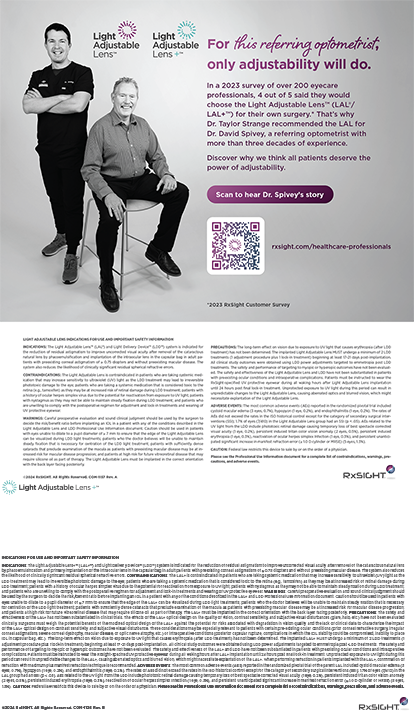In the past when patients considered cataract surgery, their discussion with the ophthalmologist was somewhat limited. The ophthalmologist would remove the cataract, and the patient would typically be happy with his or her improved corrected vision. Today’s merger between cataract and refractive surgery means patients now have many choices when it comes time to have the cataract removed. It can be a challenge to discuss presbyopia-correcting lenses with patients and to determine pricing.
EXTENDING THE EDUCATIONAL PROCESS
The biggest challenge of discussing presbyopiacorrecting IOLs is providing enough information to the patient so that he or she can make an educated decision. The more time that is spent preoperatively with the patient, the less time will be needed postoperatively. It is important to extend the educational process over a period of time as well as over multiple sessions. In my practice, initially, we tried to have the ophthalmologist explain the various IOL options in one sitting, but time was inadequate for a satisfactory discussion of the different technologies and answers to all of the patients’ concerns. The experience, moreover, was overwhelming for the patient.
The extension of the educational process starts when the patient calls to make an appointment for a consultation for cataract removal. Creating the proper mindset for patients starts at the front desk. Staff members explain to the patient that the removal of a cataract is an important decision in which many choices have to be made. They encourage the patient to bring along a family member to help with the decision-making process. Also, our staff mails a cataract information package to the patient so that he or she can start reviewing the choices.
PATIENT-EDUCATION COUNSELOR
A few days prior to the appointment, a patienteducation counselor calls the patient to ensure that he or she has received the packet. Using proper wording is extremely important. Rather than state that the patient has “options,” we say that the patient has “choices.” The word options implies an upgrade or a more luxurious item, whereas choices tends to level the playing field for the various items. Our team encourages the patient to review the information in the packet and also directs him or her to our website for additional information. Once again, the patient is encouraged to bring a family member.
When the patient arrives for the appointment, a technician performs the initial screening tests. He or she explains to the patient that the purpose of the tests is to help the surgeon make a recommendation regarding the type of cataract surgery. While the patient’s pupils are dilating, the patient-education counselor tries to assess the patient’s visual goals. The counselor discusses the patient’s hobbies and work. The counselor also describes the different choices the patient has and some of the available technologies to achieve these results. Based on these discussions, the counselor will suggest to the ophthalmologist the type of procedure that may work best for the patient.
FOCUSING ON THE REFRACTIVE OUTCOME
When meeting with the patient, the physician uses the ophthalmic examination to determine the suitability of a presbyopia-correcting lens. The ophthalmologist briefly describes some of the limitations of IOLs, including glare and halos at night and the possible need for reading glasses for some tasks. Finally, he or she will tell the patient if a presbyopia-correcting lens package will work best to achieve his or her visual goals.
Many technologies in addition to the IOL may be employed to obtain a desired refractive outcome. They include more preoperative testing with corneal topography, femtosecond laser assistance, intraoperative wavefront aberrometry, and arcuate incisions, either created manually or with the femtosecond laser. Rather than focus on the different technologies, our staff tries to focus on the final refractive outcome. We explain that we will use the various technologies to achieve the appropriate refractive outcome and provide the patient with good distance and near vision. We have found that patients are more interested in their final overall vision than the technologies used to get there.
PRICING PRESBYOPIA-CORRECTING IOLs
Initially, we offered à la carte pricing; patients chose the technologies in addition to the presbyopia-correcting lens they wanted. However, they had trouble figuring out how important certain technologies were to their final outcome, so we decided instead to offer a single global price.
Many items are included within this global price: the hard cost of the implant, use of the femtosecond laser, intraoperative wavefront aberrometry, and noncovered preoperative testing such as corneal topography and macular optical coherence tomography. Many patients will require an early YAG capsulotomy or an excimer laser enhancement. The best method of determining pricing for these two procedures would be to take a percentage of their total cost, depending upon how frequently they are needed. The most important component of the global price is the additional time required of the physician to counsel patients, both pre- and postoperatively (Table). The global price can range from $3,000 to $5,000 per eye.
CONCLUSION
By using some of the strategies discussed herein, a practice should be able to increase its overall conversion rates to presbyopia-correcting lenses. Economically, an increased conversion rate will provide additional revenue to the practice. The physician can focus on a refractive goal rather than the use of a particular technology, and patients will find it easier to choose a surgical package.
Shamik Bafna, MD, is a cataract and refractive surgeon practicing at the Cleveland Eye Clinic in Brecksville, Ohio. Dr. Bafna may be reached at (216) 287-2060; drbafna@clevelandeyeclinic.com.


